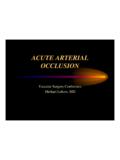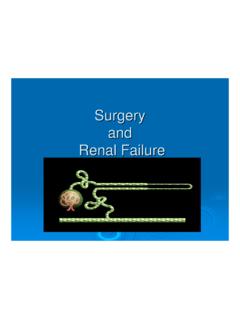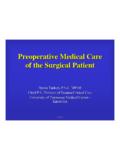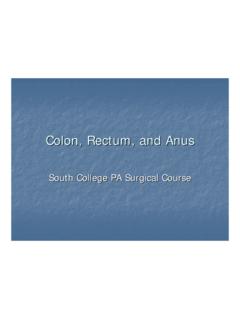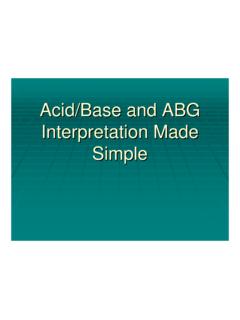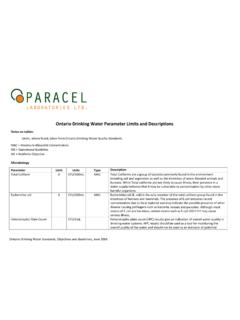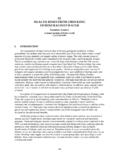Transcription of Stomach - Medical Residency Programs, Medical …
1 StomachStomachUniversity of Tennessee Medical Center in KnoxvilleUTMCKS tomachStomachEmbryologyEmbryologyUTMCKUT MCKS tomachStomachEmbryologyEmbryologyUTMCKUT MCKS tomachStomachEmbryologyEmbryologyUTMCKUT MCKS tomachStomachEmbryologyEmbryologyUTMCKUT MCKS tomachStomachAnatomyAnatomyUTMCKS tomachStomachAnatomyAnatomyUTMCKS tomachStomachAnatomyAnatomyUTMCKS tomachStomachAnatomy: Blood SupplyAnatomy: Blood SupplyUTMCKS tomachStomachAnatomy: Lymphatic DrainageAnatomy: Lymphatic DrainageUTMCKS tomachStomachAnatomy: Anatomy: InnervationInnervationUTMCKS tomachStomachHistologyHistology4 LayersLayers SerosaSerosaor or visceral visceral peritoneumperitoneum MuscularisMuscularis: : Three layersThree layers Outer Outer longitudinallongitudinal Middle circularMiddle circular Inner oblique Inner oblique SubmucosaSubmucosa MucosaMucosa3 sub layers3 sub layersUTMCKS tomachStomachHistologyHistologyUTMCKS tomachStomachHistologyHistologyUTMCKS tomachStomachHistologyHistologyUTMCKS tomachStomachPhysiology: Functions of the StomachPhysiology.
2 Functions of the Stomach Bulk storage of undigested foodBulk storage of undigested food Mechanical breakdown of foodMechanical breakdown of food Disruption of chemical bonds via acids Disruption of chemical bonds via acids and enzymes (pepsin)and enzymes (pepsin) Production of intrinsic factorProduction of intrinsic factor Very little absorption of nutrients Very little absorption of nutrients Some drugs, however, are absorbed Some drugs, however, are absorbed EnteroendocrineEnteroendocrinecells cells UTMCKS tomachStomachPhysiology: Gastric Acid SecretionPhysiology: Gastric Acid SecretionAcid production by the parietal cells in the Stomach depends on the generation of carbonic acid; subsequent movement of hydrogen ions into the gastric lumen results from primary active : Gastric Acid SecretionPhysiology: Gastric Acid SecretionOne inhibitory andthree stimulatory signals that alteracid secretion byparietal cellsin the Ach work by increasing [Ca++]Iand activate Protein KinasesHistamine works via a H2receptor and by a cAMP mechanismAll 3 work synergistically.
3 UTMCKS tomachStomachPhysiology: Gastric Acid SecretionPhysiology: Gastric Acid SecretionThe acidity in the gastric lumen converts the protease precursor pepsinogento pepsin; subsequent conversions occur quickly as a result of pepsin s protease : Regulation of Gastric Physiology: Regulation of Gastric Acid SecretionAcid SecretionUTMCKS tomachStomachPhysiology: Regulation of Gastric Physiology: Regulation of Gastric Acid SecretionAcid SecretionUTMCKS tomachStomachPhysiology: Regulation of Gastric Physiology: Regulation of Gastric Acid SecretionAcid SecretionUTMCKS tomachStomachUTMCKS tomachStomachPhysiology: MotilityPhysiology: MotilityProximal stomachNo basal electrical activitySlow tonic contractionHigh distensibilityGastric reservoirDistal stomachBasal electrical activityPeristaltic phasiccontractionsLow distensibilityGrinding of solidsUTMCKS tomachStomachPhysiology: MotilityPhysiology.
4 MotilityPeristaltic strength increases: corpus to antrumMechanical activityElectrical activityIntracellular potential (mV)12345 UTMCKS tomachStomachPhysiology: MotilityPhysiology: MotilityIsotonic Relaxation and Contractioninfuse fluidfluid outtimevolume of stomachtension in Stomach wallUTMCKS tomachStomachPhysiology: MotilityPhysiology: MotilityGastric EmptyingPropulsion-Retropulsionmechanism in the antrumContent regulates gastric emptyingnon-digestible spheresUTMCKS tomachStomachPathologyPathology Peptic Ulcer DiseasePeptic Ulcer Disease NeoplasiaNeoplasia OtherOtherUTMCKS tomachStomachPeptic Ulcer Disease (PUD)Peptic Ulcer Disease (PUD) Definition: ulcer x erosion (Definition: ulcer x erosion (muscmuscmucosa)mucosa) EpidemiologyEpidemiology 500,000 new cases per year500,000 new cases per year Prevalence > incidencePrevalence > incidence 33--4 million pts seen by MD every year4 million pts seen by MD every year 130,000 operations for PUD per year130,000 operations for PUD per year 9,000 deaths from PUD complications9,000 deaths from PUD complications Over last 20y: Over last 20y: Increase in emergency operationsIncrease in emergency operations Decrease in elective operationsDecrease in elective operationsUTMCKS tomachStomachPUD: Location and Types of UlcersPUD: Location and Types of Ulcers Type IV:Type IV.
5 Rare in the US and EuropeRare in the US and Europe Common in Latin AmericaCommon in Latin America Type I:Type I: More common (60 More common (60--70%)70%) Normal or low acid Normal or low acid secretionsecretion Not assoc with gastric or Not assoc with gastric or duodenal mucosa duodenal mucosa : Location and Types of UlcersPUD: Location and Types of Ulcers Type II:Type II: ~ 15%~ 15% Assoc with active or chronic Assoc with active or chronic duodenal ulcer diseaseduodenal ulcer disease Type III:Type III: ~ 20%~ 20% Assoc with diffuse Assoc with diffuse antralantralgastritisgastritisUTMCKS tomachStomachPUD: PathogenesisPUD: Pathogenesis Helicobacter pyloriHelicobacter pylori UreaseUreaseproductingproductingGNRGNR Association: 90% duodenal; 75% gastricAssociation: 90% duodenal; 75% gastric ?
6 Mechanism? Mechanism Local mucosal injury by toxic productsLocal mucosal injury by toxic products Induction of local immune responseInduction of local immune response Increased acid secretion: increased Increased acid secretion: increased gastringastrin(D cell (D cell destruction)destruction) Associated with low socioeconomic status (?)Associated with low socioeconomic status (?) Lifetime risk of PUD if + Lifetime risk of PUD if + : 15% (3%: 15% (3%--))UTMCKS tomachStomachPUD: PathogenesisPUD: Pathogenesis NSAIDSNSAIDS 22ndndmost cause of PUD and increasingmost cause of PUD and increasing 3 million on NSAIDS; 1 in 10 has active ulcer3 million on NSAIDS; 1 in 10 has active ulcer Risk of gastric complication: increased 2 Risk of gastric complication: increased 2--10x10x Risk is proportional to antiRisk is proportional to anti--inflaminflampotencypotency Acute or chronic injuryAcute or chronic injury Acute: within 1 Acute: within 1--2 weeks of use2 weeks of use Chronic: after 1 monthChronic: after 1 month Ulcers are more frequent in the stomachUlcers are more frequent in the stomachUTMCKS tomachStomachPUD: PathogenesisPUD: Pathogenesis Acid secretionAcid secretion Basal acid secretion: 1 Basal acid secretion: 1--8 8 mmol/hmmol/h Response to Response to pentagastrinpentagastrin: 6.
7 6--40 40 mmol/hmmol/h Gastric ulcers type II and III and duodenal Gastric ulcers type II and III and duodenal ulcers are associated with increased gastric ulcers are associated with increased gastric acid secretionacid secretion Pernicious anemia, gastric cancer, gastric Pernicious anemia, gastric cancer, gastric atrophy, gastric ulcers atrophy, gastric ulcers tipetipeI and IV are I and IV are associated with decreased basal and postassociated with decreased basal and post--pentagastrinpentagastrinacid outputacid outputUTMCKS tomachStomachPUD: PathogenesisPUD: Pathogenesis Duodenal UlcerDuodenal Ulcer Multiple etiologiesMultiple etiologies Only relatively absolute requirements:Only relatively absolute requirements: Acid and pepsin secretionAcid and pepsin secretion Combination with either NSAIDS or H.
8 PyloriCombination with either NSAIDS or H. pylori Multiple Multiple secretorysecretoryabnormalities:abnormal ities: DecrDecrduodenal duodenal bicarbbicarbsecretion: 70%secretion: 70% IncrIncrnocturnal acid secretion: 70%nocturnal acid secretion: 70% IncrIncrduodenal acid load: 65%duodenal acid load: 65% IncrIncrsensitivity to sensitivity to gastringastrin: 35% : 35% ..UTMCKS tomachStomachPUD: Clinical ManifestationsPUD: Clinical Manifestations Duodenal UlcerDuodenal Ulcer Abdominal pain: Abdominal pain: varies; most common is well localized midvaries; most common is well localized mid--epigastricepigastricpainpain relieved by foodrelieved by food May be episodic or seasonal in spring and fall or by May be episodic or seasonal in spring and fall or by stressstress Constant pain: ?
9 Deeper penetration of the ulcerConstant pain: ? Deeper penetration of the ulcer Back pain: ? Perforation/penetration into the Back pain: ? Perforation/penetration into the pancreaspancreasUTMCKS tomachStomachPUD: Clinical ManifestationsPUD: Clinical Manifestations Duodenal UlcerDuodenal Ulcer PerforationPerforation 5%: free perforation into the peritoneal cavity5%: free perforation into the peritoneal cavity Patient recalls exact time of onsetPatient recalls exact time of onset Accompanied by fever, tachycardia, dehydration, Accompanied by fever, tachycardia, dehydration, ileusileus Abdominal PE: tenderness, rigidity, reboundAbdominal PE: tenderness, rigidity, rebound Hallmark: free air underneath the diaphragm on Hallmark: free air underneath the diaphragm on XRayXRayUTMCKS tomachStomachPUD: Clinical ManifestationsPUD.
10 Clinical Manifestations Duodenal UlcerDuodenal Ulcer BleedingBleeding Most common cause of death (usually >65 Most common cause of death (usually >65 yoyoand and with multiple with multiple comorbiditiescomorbidities)) GastroduodenalGastroduodenalarteries lie directly posteriorarteries lie directly posterior However, most present as minor bleeding by more However, most present as minor bleeding by more superficial ulcerssuperficial ulcersUTMCKS tomachStomachPUD: Clinical ManifestationsPUD: Clinical Manifestations Duodenal UlcerDuodenal Ulcer ObstructionObstruction Acute: functional GOO with associated Acute: functional GOO with associated inflammationinflammation Delayed gastric emptying with N/V, anorexiaDelayed gastric emptying with N/V, anorexia Prolonged vomiting may cause hypo Prolonged vomiting may cause hypo Cl,K,HCl,K, Chronic: recurrent inflammation/healing/scarring Chronic: recurrent inflammation/healing/scarring leading to obstructionleading to obstruction Painless vomiting of large amountsPainless vomiting of large amounts Similar metabolic abnormalitiesSimilar metabolic abnormalities Stomach may become massively dilatedStomach may become massively dilated MalnutritionMalnutritionUTMCKS tomachStomachPUD: Clinical ManifestationsPUD: Clinical Manifestations Gastric UlcerGastric Ulcer Abdominal pain.

